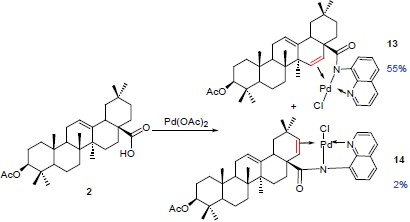| [1] (a) Tschesche, R.; Wulff, G. Fortschr. Chem. Org. Naturst. 1973, 30, 461; (b) Hostettmann, K.; Marston, A. Saponins, Cambridge University, Cambridge, UK, 1995. [2] (a) Advances in Experimental Medicine and Biology, Vol. 404, Eds.: Waller, G. R.; Yamasaki, K., Plenum Press, New York, 1996; (b) Sparg, S. G.; Light, M. E.; Staden, J. V. J. Ethnopharmacol. 2004, 94, 219. [3] Vincken, J. P.; Heng, L.; Groot, A. D.; Gruppen, H. Phytochemistry 2011, 71, 435. [4] Augustin, J. M.; Kuzina, V.; Andersen, S. B.; Bak, S. Phytochemistry 2007, 68, 275. [5] Sheng, H. M.; Sun, H. B. Nat. Prod. Rep. 2011, 28, 543[6] (a) Yu, B.; Sun, J. S. Chem. Asian J. 2009, 4, 642; (b) Yu, B.; Sun, J. S.; Yang, X. Y. Acc. Chem. Res. 2012, 45, 1227; (b) Yu, B.; Zhang, Y. C.; Tang, P. P. Eur. J. Org. Chem. 2007, 5145; (c) Pellissier, H. Tetrehedron 2004, 60, 5123. [7]Sun, H.; Liu, T.; Shen, Y. J.; Zang, L. M.; Wang, M. Chin. J. Struct. Chem. 2010, 29, 1798. [8] For a recent review on the glycosylation methods, see: Zhu, X. M.; Schmidt, R. R. Angew. Chem., Int. Ed. 2009, 48, 1900. [9] (a) Herrmann, P.; Bach, T. Chem. Soc. Rev. 2011, 40, 2022; (b) Lyons, T. W.; Sanford, M. S. Chem. Rev. 2010, 110, 1147; (c) Desai, L. V.; Hull, K. L.; Sanford, M. S. J. Am. Chem. Soc. 2004, 126, 9542; (d) Zaitsev, V. G.; Shabashov, D.; Daugulis, O. J. Am. Chem. Soc. 2005, 127, 13154; (e) Shabashov, D.; Daugulis, O. J. Am. Chem. Soc. 2010, 132, 3965; (f) Neufeldt, S. R.; Sanford, M. S. Acc. Chem. Res. 2012, 45, 936; (g) Giri, R.; Chen X.; Yu, J. Q. Angew. Chem., Int. Ed. 2005, 44, 2112; (h) Neufeldt, S. R.; Sanford, M. S. Org. Lett. 2010, 12, 532; (i) Reddy, B. V. S.; Reddy, L. R.; Corey, E. J. Org. Lett. 2006, 8, 3391.[10] Shamsuddin, K. M.; Zobairi, M. O.; Musharraf, M. A. Tetrahedron Lett. 1998, 39, 8153. [11] Le M閚ez, P.; Hamze, A.; Provot, O.; Brion, J. D.; Alami, M. Synlett 2010, 7, 1101. [12] (a) Nahm, S.; Weinreb, S. M. Tetrahedron Lett. 1981, 22, 3815; (b) Keck, G. E.; Palani, A.; McHardy, S. F. J. Org. Chem. 1994, 59, 3113.[13] (a) Li, H.; Zou, H.; Gao, L. X.; Liu, T.; Yang, F.; Li, J. Y.; Li, J.; Qiu, W. W.; Tang, J. Heterocycles 2012, 85, 1117; (b) Zhu, C. S.; Tang, P. P.; Yu, B. J. Am. Chem. Soc. 2008, 130, 5872. [14] CCDC 923435, 923429, 923434, 923436 contain the supplementary crystallographic data for compounds 13, 14, 15, and 17, respectively. These data can be obtained free of charge from the Cambridge Crystallographic Data Centre via www.ccdc.cam.ac.uk/ data_request/cif. [15] Gou, F. R.; Wang, X. C.; Huo, P. F.; Bi, H. P.; Guan, Z. H.; Liang, Y. M. Org. Lett. 2009, 11, 5726. [16] Feng, Y. Q.; Wang, Y. J.; Landgraf, B.; Liu, S.; Chen, G. Org. Lett. 2010, 12, 3414. [17] Lafrance, M.; Gorelsky, S. I.; Fagnou, K. J. Am. Chem. Soc. 2007, 129, 14570. |
